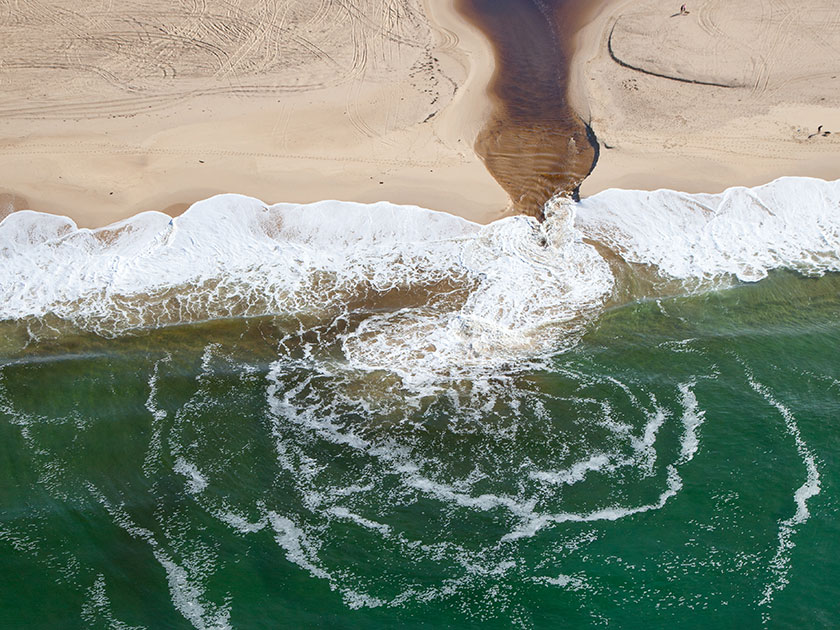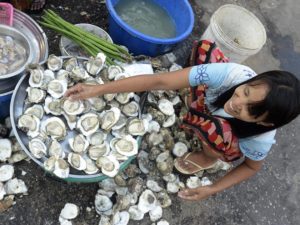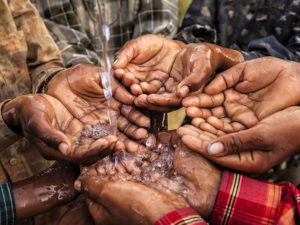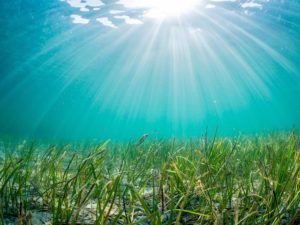
Photo: iStock
Sewage pollution is an especially pernicious ocean threat, due to the many types of pollutants it contains; the direct and indirect ways it pollutes freshwater, nearshore, coastal, and marine systems throughout a watershed; its global reach; its myriad impacts; and its relative neglect by philanthropic and development aid communities. The problem is both technological and related to infrastructure investment—as evidenced by the pervasiveness of inadequate and often aging infrastructure worldwide. This issue is also stymied by human behavior challenges, given the associated cultural taboos that often inhibit discussion and action.
Typical components of sewage include water, nutrients, organic matter, bacteria, viruses, parasites, endocrine disruptors, suspended solids, micro and macro plastics, microfibers, industrial chemicals, slaughterhouse wastes, sediments and heavy metals—each of which individually and together work to harm coastal and marine ecosystems.1
Sewage enters the ocean in a variety of ways. By far the largest volume of waste discharged into the oceans is sewage.2 Sewage pollution enters the ocean readily in areas without adequate sanitation and wastewater treatment facilities, but can also easily be discharged where treatment facilities do exist due to aging infrastructure, facility malfunctions, and heavy rains that overwhelm systems and lead to combined sewer overflows.3 Sewage can also discharge directly from sewage treatment plants via outfalls (treated or untreated), as it is at many wastewater treatment plants along all coastal regions in the United States. Sewage can be discharged directly into upstream ecosystems like streams, rivers, wetlands, and estuaries before ultimately reaching the coast and ocean. It can be indirectly washed into rivers via runoff or stormwater or released directly into the ocean, which is often the case in low-income cities and towns where open sewers are the norm, or high-income cities where stormwater and sewage drains are combined. Finally, sewage can seep or be pumped into groundwater, which may or may not filter out pollutants depending on the geology.
This is a global problem, with equally significant challenges in high-, middle-, and low-income countries alike. Sewage makes up the largest percentage of coastal pollution worldwide.4 Globally, an estimated 80 percent of sewage is discharged into the environment untreated.5 A global estimate showed that 104 of 112 major nearshore coral reef systems have persistent sewage problems.6 More than 60 percent of all bays in the U.S. Atlantic region are at risk of seagrass decline due to nitrogen loading, while mangroves, salt marshes, and oyster reefs in the region are declining as a direct result of sewage pollution.7-10 Major coastal cities and urban environments are usually significant sources of pollution, especially in low-income countries. However, even in high-income countries this challenge is present; for instance, utilities in England reportedly discharged raw sewage into the country’s rivers 200,000 times in 2019.11
This is a global problem, with equally significant challenges in high-, middle-, and low-income countries alike. Sewage makes up the largest percentage of coastal pollution worldwide. Globally, an estimated 80 percent of sewage is discharged into the environment untreated.
While the impacts of sewage pollution on the marine environment are relatively understudied in comparison to other threats, research indicates that it is a significant threat to ocean health.12 A recent study that examined the pace of change in human impacts on marine and coastal ecosystems found that climate change stressors (i.e., sea surface temperature, ocean acidification, and sea level rise) are driving most of the change at both global and coastal scales.13 However, land-based pollution stressors are increasing globally and account for high cumulative impact, particularly on coral reefs and other coastal environments such as seagrasses, salt marshes, mangroves, and intertidal ecosystems.14 In fact, one of the top three threats to marine ecosystems overall is point-source organic nutrient pollution, the majority of which can originate from sewage pollution, depending on geography, with agriculture being the other primary source.15
The tremendous volume of sewage humans discharge into the ocean kills marine life, degrades critical habitats, and harms the ecosystems upon which humans depend, while remaining a threat to human health. Sewage pollution can be linked to the following impacts:
- Eutrophication due to nutrient overload that depletes oxygen, kills marine flora and fauna, and disrupts ecological processes.16
- Harmful algal blooms that can produce toxins or physical material (i.e., sargassum) that kill marine life, close beaches, and can cause human disease through direct exposure and indirectly through consumption of contaminated seafood.17,18
- Physical and biological damage to coral reefs, seagrasses, and salt marshes where it can smother habitat, lead to high levels of local acidification, and increase risk of disease.19
- Loss of coastal ecosystem services, like erosion control, buffers from storms, and nurseries for juvenile fish.20-25
- Animal and human diseases resulting from pathogens, heavy metals, and toxic chemicals that can cause acute disease, as well as long-term disruptions to biological processes.26-28
- Contamination of fisheries and fish mortality as well as reductions in species diversity in polluted areas because of decreased dissolved oxygen (due to increases in nutrient levels) and algal toxins.29-30
Sewage contains a wide array of pollutants that are harmful not only to ocean health but also to public health. Typical components of sewage include water, nutrients, organic matter, bacteria, viruses, parasites, endocrine disruptors, suspended solids, micro and macro plastics, microfibers, industrial chemicals, slaughterhouse wastes, sediments and heavy metals—each of which both individually and together work to harm coastal and marine ecosystems.31 The fate and transport of these pollutants in the marine environment is often not well-understood. Bacteria, viruses and parasites are thought to be “processed” biologically in a matter of weeks; heavy metals, pesticides, toxic chemicals, and plastics may persist indefinitely, and bioaccumulate in sediments, plants, and marine animals; solids and organic matter typically stay locally, and settle on the benthos, smothering plants and animals; and nutrients can both stay locally and be transported far away over months.32-33

Related article: Sewage Pollution Threatens the Safety of the Global Seafood Supply. Photo: iStock
Sewage pollution deeply affects public health, quality of life, and coastal identity and economies, especially for poor, vulnerable, and marginalized groups. Beyond the ecological impacts, sewage pollution degrades the coastal ecosystems people rely on for recreation, subsistence, jobs, and culture, while at the same time polluting local drinking water sources. Sewage pollution results in beach closures and fishery closures as a result of contamination and its associated impacts such as toxins from harmful algal blooms.34-35 For example, one study found that combined sewer overflows in the Machias Bay in Maine from 2001 to 2009 led to USD 2 million in economic losses due to temporary closures of soft-shell clam harvesting.36 One of the largest fisheries closures due to a harmful algal bloom occurred in 17 fishing communities on the U.S. West Coast in 2015, leading to an estimated USD 97.5 million loss in the Dungeness crab fishery alone.37 Sewage pollution leads to the degradation and contamination of resources that many rely on for customary or traditional use. It can also seep into groundwater, elevating levels of nitrates and other pollutants that may be harmful to human health.38
The cultural taboo of discussing sewage presents a real, but invisible, barrier to addressing the issue. The magnitude of the effect that human waste has on the environment is deeply unglamorous and therefore the effects of sewage pollution on ocean health continue to be largely overlooked. In addition, funding and attention directed towards the water, sanitation, and hygiene sector (WASH) is often more focused on human health, safety, and quality of life impacts from unmanaged human waste than its environmental impacts. There remains a significant blind spot around where sewage ultimately ends up—which is, in many cases, freshwater, coastal, and marine environments.
The cultural taboo of discussing sewage presents a real, but invisible, barrier to addressing the issue. The magnitude of the effect that human waste has on the environment is deeply unglamorous and therefore the effects of sewage pollution on ocean health continue to be largely overlooked.

Related article: Leveraging Behavioral Insights to Solve Our Sewage Pollution Crisis. Photo: iStock
Although progress is being made, most of the world’s population does not have access to adequate sanitation to protect public health, much less to protect the environment. According to the World Health Organization (WHO), nearly 6 in 10 people did not have access to safely managed sanitation services in 2017; put another way, 4.2 billion people use only basic, limited, unimproved services, or otherwise practice open defecation.39 Achieving universal access by 2030 will require a doubling of the current rate of increase. Furthermore, the WHO’s definition of “safely managed services”—a private, improved facility where fecal wastes are safely disposed on site or transported and treated off-site, plus a hand-washing facility with soap and water—is representative of global Sustainable Development Goals, which are designed to meet human health standards, but do not explicitly focus on reducing environmental pollution from human waste.40
Sewage pollution is largely neglected by the marine conservation funding community. A funding analysis commissioned in 2019 found that ocean sewage pollution received only USD 6 million annually in philanthropic funding between 2006 and 2019.41 The overwhelming majority of this funding was distributed to grantees within the U.S.42 For scale, philanthropic funding for the WASH sector totaled USD 410 million in 2016 alone, while in the same year, philanthropic funding for marine conservation totaled USD 621 million.43 Major philanthropies and ocean conservation NGOs that do focus on coastal pollution tend to focus primarily on plastic and solid waste management. Top WASH funders tend to be motivated by improving public health, mitigating climate change, and alleviating poverty. Ocean sewage pollution remains on the periphery for both marine conservation and WASH funders, with neither sector making significant investments in the space.
Sewage pollution is largely neglected by the marine conservation funding community. A funding analysis commissioned in 2019 found that ocean sewage pollution received only USD 6 million annually in philanthropic funding between 2006 and 2019.
Within the research community, sewage pollution has been an under-studied issue historically. Compared to many other ocean threats, sewage as a pollutant has received less attention than other threats to ocean health. The body of literature and attention directed to plastics, for example, is quite significant in comparison. While sufficient research exists to link the components of sewage pollution such as nutrients, heavy metals, and indeed, microplastics, to the degradation of marine ecosystems and impacts on marine life, sewage as a source for these types of pollution is relatively understudied. To date, there are few comprehensive analyses that attempt to assess the scale of the impact of sewage pollution on the marine environment.
The impacts of sewage pollution also expose inequities in access to basic services and the ways in which environmental and social burdens disproportionately affect the most vulnerable. Lack of access to adequate sanitation can confer burdens of time and energy on low-income households and communities in addition to the obvious health effects of poor sanitation, including diarrheal diseases. While these impacts are by far most acutely and frequently felt in low-income and lower middle-income countries, communities within even the wealthiest countries in the world continue to suffer from the impacts of a lack of sanitation infrastructure and adequate wastewater treatment. From instances of diarrheal diseases and associated mortality in children in Asia and sub-Saharan Africa, to nitrate pollution in the drinking water of U.S. rural populations, to illnesses caused by harmful algal bloom toxins in people and animals worldwide, sewage pollution brings heavy costs where it occurs.
To learn more about the solution sets to address ocean sewage pollution, please visit our Solutions Synthesis here.

Related article: Blue Solutions: Seagrass Ecosystems as an Alternative to Built Wastewater Treatment Infrastructure. Photo: iStock
Notes
- Jambeck, Jenna, Ellie Moss, Brajesh Dubey, Zainal Arifin, Linda Godfrey, Britta Denise Hardesty, I Gede Hendrawan, et al. “Leveraging Multi-Target Strategies to Address Plastic Pollution in the Context of an Already Stressed Ocean,” n.d., 68.
- Islam, Md. Shahidul, and Masaru Tanaka. “Impacts of Pollution on Coastal and Marine Ecosystems Including Coastal and Marine Fisheries and Approach for Management: A Review and Synthesis.” Marine Pollution Bulletin 48, no. 7 (2004): 624–49. https://doi.org/10.1016/j.marpolbul.2003.12.004.
- Jambeck, Jenna, Ellie Moss, Brajesh Dubey, Zainal Arifin, Linda Godfrey, Britta Denise Hardesty, I Gede Hendrawan, et al. “Leveraging Multi-Target Strategies to Address Plastic Pollution in the Context of an Already Stressed Ocean.”
- Wear, Stephanie L., and Rebecca Vega Thurber. “Sewage Pollution: Mitigation Is Key for Coral Reef Stewardship.” Annals of the New York Academy of Sciences 1355, no. 1 (2015): 15–30. https://doi.org/10.1111/nyas.12785.
- “The United Nations World Water Development Report 2017. Wastewater the Untapped Resource.” United Nations World Water Assessment Programme, 2017. http://www.unesco.org/new/en/natural-sciences/environment/water/wwap/wwdr/.
- Wear, Stephanie L., and Rebecca Vega Thurber. “Sewage Pollution: Mitigation Is Key for Coral Reef Stewardship.”
- Casey, Michael, and Andrew Selsky. “Scientists Struggle to Save Seagrass from Coastal Pollution.” AP, December 23, 2019. https://apnews.com/6b6dd238cee841ed8e5772722c6a1911.
- Mandura, A.S. “A Mangrove Stand under Sewage Pollution Stress: Red Sea.” Mangroves and Salt Marshes 1, no. 4 (1997): 255–62. https://doi.org/10.1023/A:1009927605517.
- Deegan, Linda A., David Samuel Johnson, R. Scott Warren, Bruce J. Peterson, John W. Fleeger, Sergio Fagherazzi, and Wilfred M. Wollheim. “Coastal Eutrophication as a Driver of Salt Marsh Loss.” Nature 490, no. 7420 (2012): 388–92. https://doi.org/10.1038/nature11533.
- Beck, Michael W., Robert D. Brumbaugh, Laura Airoldi, Alvar Carranza, Loren D. Coen, Christine Crawford, Omar Defeo, et al. “Oyster Reefs at Risk and Recommendations for Conservation, Restoration, and Management.” BioScience 61, no. 2 (2011): 107–16. https://doi.org/10.1525/bio.2011.61.2.5.
- Laville, Sandra, and Niamh McIntyre. “Exclusive: Water Firms Discharged Raw Sewage into England’s Rivers 200,000 Times in 2019.” The Guardian, July 1, 2020, sec. Environment. https://www.theguardian.com/environment/2020/jul/01/water-firms-raw-sewage-england-rivers.
- Halpern, Benjamin S., Kimberly A. Selkoe, Fiorenza Micheli, and Carrie V. Kappel. “Evaluating and Ranking the Vulnerability of Global Marine Ecosystems to Anthropogenic Threats.” Conservation Biology 21, no. 5 (2007): 1301–15. https://doi.org/10.1111/j.1523-1739.2007.00752.x.
- Halpern, Benjamin S., Melanie Frazier, Jamie Afflerbach, Julia S. Lowndes, Fiorenza Micheli, Casey O’Hara, Courtney Scarborough, and Kimberly A. Selkoe. “Recent Pace of Change in Human Impact on the World’s Ocean.” Scientific Reports 9, no. 1 (2019): 11609. https://doi.org/10.1038/s41598-019-47201-9.
- Ibid.
- Halpern, Benjamin S., Kimberly A. Selkoe, Fiorenza Micheli, and Carrie V. Kappel. “Evaluating and Ranking the Vulnerability of Global Marine Ecosystems to Anthropogenic Threats.”
- Islam, Md. Shahidul, and Masaru Tanaka. “Impacts of Pollution on Coastal and Marine Ecosystems Including Coastal and Marine Fisheries and Approach for Management: A Review and Synthesis.”
- Twiner, Michael J., Spencer Fire, Lori Schwacke, Leigh Davidson, Zhihong Wang, Steve Morton, Stephen Roth, Brian Balmer, Teresa K. Rowles, and Randall S. Wells. “Concurrent Exposure of Bottlenose Dolphins (Tursiops Truncatus) to Multiple Algal Toxins in Sarasota Bay, Florida, USA.” PLOS ONE 6, no. 3 (2011): e17394. https://doi.org/10.1371/journal.pone.0017394.
- Gannon, Damon P., Elizabeth J. Berens McCabe, Sandra A. Camilleri, Janet G. Gannon, Mary K. Brueggen, Aaron A. Barleycorn, Valeriy I. Palubok, Gary J. Kirkpatrick, and Randall S. Wells. “Effects of Karenia Brevis Harmful Algal Blooms on Nearshore Fish Communities in Southwest Florida.” Marine Ecology Progress Series 378 (2009): 171–86. https://doi.org/10.3354/meps07853.
- Islam, Md. Shahidul, and Masaru Tanaka. “Impacts of Pollution on Coastal and Marine Ecosystems Including Coastal and Marine Fisheries and Approach for Management: A Review and Synthesis.”
- Barbier, Edward B., Sally D. Hacker, Chris Kennedy, Evamaria W. Koch, Adrian C. Stier, and Brian R. Silliman. “The Value of Estuarine and Coastal Ecosystem Services.” Ecological Monographs 81, no. 2 (2011): 169–93. https://doi.org/10.1890/10-1510.1.
- Cooley, Sarah R., Hauke L. Kite-Powell, and Scott C. Doney. “Ocean Acidification’s Potential to Alter Global Marine Ecosystem Services.” Oceanography 22, no. 4 (2009): 172–81.
- Cabral-Oliveira, J., S. Mendes, P. Maranhão, and M. A. Pardal. “Effects of Sewage Pollution on the Structure of Rocky Shore Macroinvertebrate Assemblages.”
- Krause, Johannes R., Elizabeth Burke Watson, Cathleen Wigand, and Nicole Maher. “Are Tidal Salt Marshes Exposed to Nutrient Pollution More Vulnerable to Sea Level Rise?”
- Halpern, Benjamin S., Kimberly A. Selkoe, Fiorenza Micheli, and Carrie V. Kappel. “Evaluating and Ranking the Vulnerability of Global Marine Ecosystems to Anthropogenic Threats.”
- Santos, Carmen B. de los, Dorte Krause-Jensen, Teresa Alcoverro, Núria Marbà, Carlos M. Duarte, Marieke M. van Katwijk, Marta Pérez, et al. “Recent Trend Reversal for Declining European Seagrass Meadows.”
- “The Impacts of Beach Pollution.” National Resource Defense Council, 2014. https://www.nrdc.org/sites/default/files/ttw2014_Impacts_of_Beach_Pollution.pdf.
- Liney, Katherine E., Josephine A. Hagger, Charles R. Tyler, Michael H. Depledge, Tamara S. Galloway, and Susan Jobling. “Health Effects in Fish of Long-Term Exposure to Effluents from Wastewater Treatment Works.” Environmental Health Perspectives 114, no. Suppl 1 (2006): 81–89. https://doi.org/10.1289/ehp.8058.
- Islam, Md. Shahidul, and Masaru Tanaka. “Impacts of Pollution on Coastal and Marine Ecosystems Including Coastal and Marine Fisheries and Approach for Management: A Review and Synthesis.”
- Bonsdorff, E., E. M. Blomqvist, J. Mattila, and A. Norkko. “Coastal Eutrophication: Causes, Consequences and Perspectives in the Archipelago Areas of the Northern Baltic Sea.” Estuarine, Coastal and Shelf Science 44 (1997): 63–72. https://doi.org/10.1016/S0272-7714(97)80008-X.
- Islam, Md. Shahidul, and Masaru Tanaka. “Impacts of Pollution on Coastal and Marine Ecosystems Including Coastal and Marine Fisheries and Approach for Management: A Review and Synthesis.”
- Jambeck, Jenna, Ellie Moss, Brajesh Dubey, Zainal Arifin, Linda Godfrey, Britta Denise Hardesty, I Gede Hendrawan, et al. “Leveraging Multi-Target Strategies to Address Plastic Pollution in the Context of an Already Stressed Ocean.”
- Islam, Md. Shahidul, and Masaru Tanaka. “Impacts of Pollution on Coastal and Marine Ecosystems Including Coastal and Marine Fisheries and Approach for Management: A Review and Synthesis.”
- “Report to Congress on Impacts and Control of Combined Sewer Overflows and Sanitary Sewer Overflows.” United States Environmental Protection Agency, 2004. https://www.epa.gov/npdes/2004-npdes-cso-report-congress.
- Moore, Stephanie K., Michael R. Cline, Kathryn Blair, Terrie Klinger, Anna Varney, and Karma Norman. “An Index of Fisheries Closures Due to Harmful Algal Blooms and a Framework for Identifying Vulnerable Fishing Communities on the U.S. West Coast.” Marine Policy 110 (2019): 103543. https://doi.org/10.1016/j.marpol.2019.103543.
- Zohdi, E., and M. Abbaspour. “Harmful Algal Blooms (Red Tide): A Review of Causes, Impacts and Approaches to Monitoring and Prediction.” International Journal of Environmental Science and Technology 16, no. 3 (2019): 1789–1806. https://doi.org/10.1007/s13762-018-2108-x.
- Evans, Keith S., Kevin Athearn, Xuan Chen, Kathleen P. Bell, and Tora Johnson. “Measuring the Impact of Pollution Closures on Commercial Shellfish Harvest: The Case of Soft-Shell Clams in Machias Bay, Maine.” Ocean & Coastal Management 130 (2016): 196–204. https://doi.org/10.1016/j.ocecoaman.2016.06.005.
- Moore, Stephanie K., Michael R. Cline, Kathryn Blair, Terrie Klinger, Anna Varney, and Karma Norman. “An Index of Fisheries Closures Due to Harmful Algal Blooms and a Framework for Identifying Vulnerable Fishing Communities on the U.S. West Coast.”
- Wakida, Fernando T., and David N. Lerner. “Non-Agricultural Sources of Groundwater Nitrate: A Review and Case Study.” Water Research 39, no. 1 (2005): 3–16. https://doi.org/10.1016/j.watres.2004.07.026.
- “Progress on Household Drinking Water, Sanitation and Hygiene 2000-2017. Special Focus on Inequalities.” United Nations Children’s Fund and World Health Organization, 2019.
- “Annex 2: Safely Managed Sanitation Services.” World Health Organization. Accessed August 17, 2020. https://www.who.int/water_sanitation_health/monitoring/coverage/explanatorynote-sdg-621-safelymanagedsanitationsServices161027.pdf?ua=1.
- Independent analysis commissioned by CEA Consulting, 2019.
- Ibid.
- Ibid.

